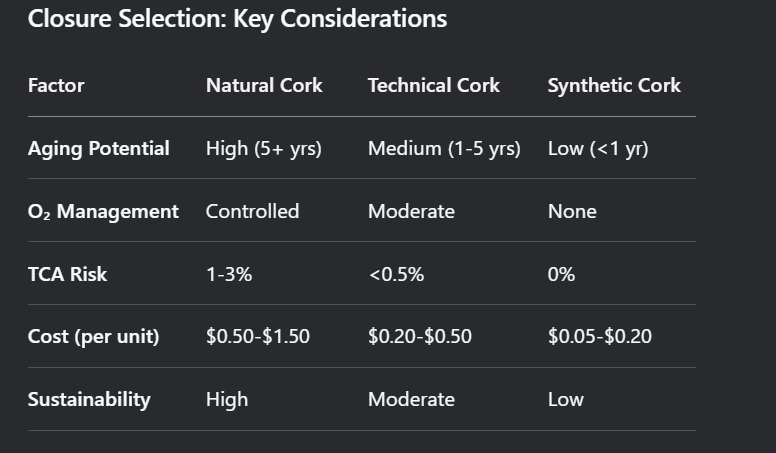Cork Types Explained: Natural vs. Technical vs. Synthetic
Last updated: 12 Jun 2025 | 1314 Views |

1. Natural Cork
Composition: Harvested from the bark of Quercus suber (cork oak) trees, primarily sourced from Portugal, Spain, and North Africa.
Key Attributes:
✔ Oxygen Permeability: Allows controlled micro-oxygenation (0.001-0.1 mg O₂/day), essential for wine evolution.
✔ Aging Potential: Ideal for wines intended for 5+ years of cellaring (e.g., Bordeaux, Barolo, Vintage Port).
✔ Sustainability: Biodegradable and supports cork oak forest ecosystems (carbon-negative production).
Challenges:
Cork Taint (TCA): ~1-3% risk of 2,4,6-trichloroanisole contamination, causing musty off-aromas.
Inconsistency: Natural porosity can lead to bottle variation.
Industry Usage: Preferred for premium and age-worthy wines.
2. Technical Cork (Agglomerated/Twin Top)
Composition: Granulated cork bound with food-grade glue, often with natural cork discs at wine-contact surfaces.
Key Attributes:
✔ Consistency: More uniform oxygen transfer (~0.05 mg O₂/day) than natural cork.
✔ Cost-Effective: ~30-50% cheaper than full natural corks.
✔ Reduced TCA Risk: Treated to minimize taint (risk <0.5%).
Challenges:
Limited aging potential (best for 1-5 years).
Perceived as less premium than natural cork.
Industry Usage: Common for mid-tier wines (e.g., $15-$50 retail).
3. Synthetic Cork (Polymer-Based)
Composition: Manufactured from PET or elastomers designed to mimic traditional cork.
Key Attributes:
✔ TCA-Free: Eliminates cork taint risk entirely.
✔ Consistency: Provides a hermetic seal (near-zero O₂ ingress).
✔ Cost: Lowest production cost among closures.
Challenges:
Zero Oxygen Exchange: Unsuitable for aging; can lead to reductive aromas (e.g., sulfur).
Environmental Impact: Petroleum-based, non-biodegradable.
Consumer Perception: Often associated with lower-quality wines.
Industry Usage: Primarily used for high-volume, value wines intended for immediate consumption.
------------------------------------------------------------------------
Emerging Alternatives
Screw Caps (Stelvin): Neutral O₂ transfer, dominant in Australia/NZ; ideal for freshness (e.g., Sauvignon Blanc).
Glass Stoppers (Vino-Lok): Airtight, reusable, and premium-positioned.
Hybrid Closures: Combining cork with synthetic materials for balance.
-----------------------------------------------------------------------

Professional Recommendation
Fine Wines: Natural cork for optimal aging.
Mid-Tier Wines: Technical cork for balance of cost/performance.
High-Volume Wines: Synthetic or screw cap for consistency.



